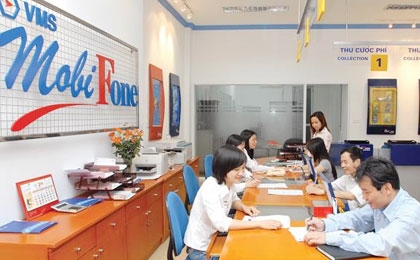Jury out on telco merger deal

Mobifone - illustration photo
>> Ministry yet to approve VNPT’s merger plan: official
>> MobiFone and VinaPhone set for a merger
The Ministry of Information and Communications’s (MIC) 2011 Information Technology While Book showed that VinaPhone held a 28.71 per cent market share and MobiFone 29.11 per cent market share in subscriber counts.
Assuming MobiFone and VinaFone were merged under a VNPT scheme (both operators are managed by VNPT, a leading state telecom group), the VNPT would hold a dominant share in three crucial segments in the local telecom services market, with the fixed line segment at a 72.94 per cent market share, internet surfing 72 per cent and mobile phone services 57.82 per cent.
The plan would be banned if the Law on Competition’s Clause 18 was factored in, which stipulates that an economic concentration will be prohibited if combined share of businesses surpassed 50 per cent of total market share.
However, this alone is not enough to hurt these big telecom operators’ merger plan.
Decree 25/ND-CP/2011 guiding the implementation of some articles in the Telecom Law stipulates for economic concentrations in the telecom services market in which the combined market share of relevant businesses ranging from 30-50 per cent relevant businesses are obliged to report to specialised telecom management authority. If the combined market share surpasses 50 per cent, the Minister of Industry and Trade will issue exemption decisions after getting exemption documents from MIC.
Clause 19 in the Law on Competition, however, presents two exemptions.
Lawyer Tran Vu Hai, head of Tran Vu Hai Lawyer Office and Hanoi Law Company, argued exemption regulation only took effect if the two would-be-merge businesses dissolved or went bankrupt. In this case, both MobiFone and VinaPhone are healthy and operating profitably.
“These two operators’ merger violates the Competition Law or not depends on work results by the Competition Council factoring on the date of birth of the Competition Law, the foundation of these two operators and relevant documents,” said Hai.
The Ministry of Industry and Trade’s Vietnam Competition Authority deputy chief Vu Ba Phu said market share was not a sole criterion in considering the deal. “Enhanced competitiveness after a merger, market access capacity and opportunities for new comers are more important factors. Management and supervision by relevant state bodies in post-merger period is of foremost importance since the market share may vary year-on-year,” said Phu.
In fact, under the Competition Law, exemption also applies in case merger and consolidation helps expand export and brings benefits to sciences and society. In this case, firms must submit exemption records to the Vietnam Competition Authority and the government, the final decision is pending on the prime minister.
From an observer’s angle, Freshfields Bruckhaus Deringer Vietnam managing partner Tony Foster said any MobiFone and VinaPhone merger would undermine Vietnam’s telecom market competitiveness. Operation by two leading state giants VNPT and Viettel should be put under close eyes by management authorities to shield consumer interests.
“The best option in restructuring VNPT would be equitising MobiFone,” said lawyer Tran Vu Hai, adding that state interests should be taken as the top factor in VNPT restructuring plan.
Hai suggested the state hold 51 per cent stake in MobiFone after equitising in which VNPT keeps 20 per cent with the remaining 32 per cent to be retained by the State Capital Investment Corporation.
What the stars mean:
★ Poor ★ ★ Promising ★★★ Good ★★★★ Very good ★★★★★ Exceptional
Related Contents
Latest News
More News
- Businesses ramp up production as year-end orders surge (December 30, 2025 | 10:05)
- Vietjet chairwoman awarded Labour Hero title (December 29, 2025 | 13:06)
- How to unlock ESG value through green innovation (December 29, 2025 | 10:03)
- AI reshapes media and advertising industry (December 29, 2025 | 08:33)
- FPT and GELEX sign deal to develop blockchain tech for global markets (December 29, 2025 | 08:29)
- Vietnam’s GDP forecast to grow by 9 per cent in 2026 (December 29, 2025 | 08:29)
- Women entrepreneurs are key to Vietnam’s economic growth (December 29, 2025 | 08:00)
- Vietnam's top 500 value-creating enterprises announced (December 27, 2025 | 08:00)
- The PAN Group shaping a better future with ESG strategy (December 26, 2025 | 09:00)
- Masan Consumer officially lists on HSX, marking the next phase of value creation (December 25, 2025 | 13:20)

 Tag:
Tag:





















 Mobile Version
Mobile Version